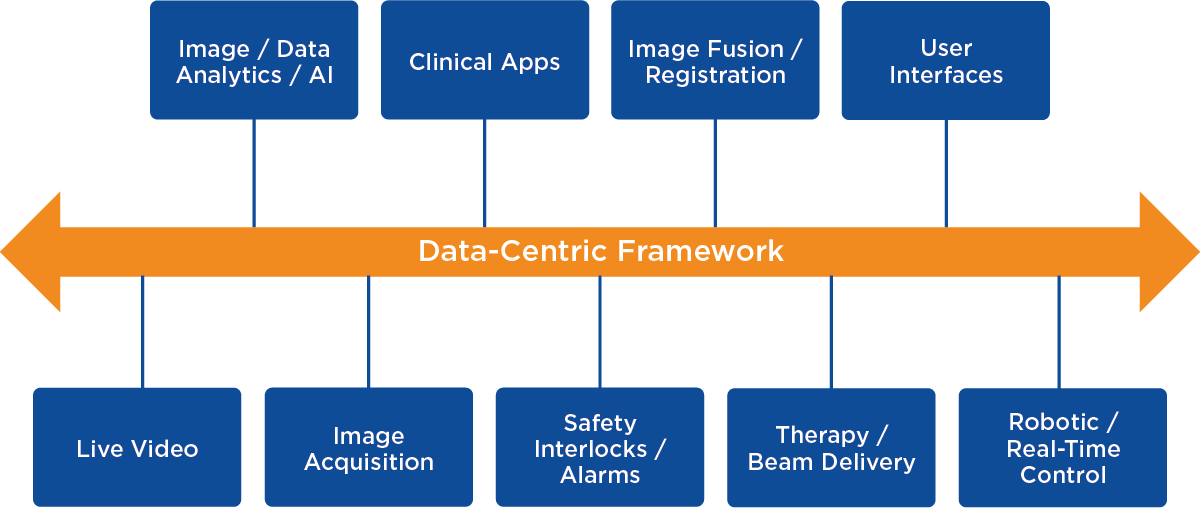3 min read
Developing Flexible Connected Medical Devices with Smart Software Data Connectivity
 Sashi Kollipara
:
November 15, 2022
Sashi Kollipara
:
November 15, 2022

Healthcare is changing rapidly. With significant advances in AI, data analytics and robotics devices, manufacturers are challenged to incorporate these technologies into their products while leveraging data fusion from several sources, systems and subsystems. The design of these products must also provide for continuous evolution and interoperability either by upgrading the product already in service, or releasing a new version or a derivative. Based on these key challenges imposed on product development, this blog presents a system architecture with flexibility as its salient property.
Here are the most important principles for flexible software architectures:
- Architecture Layer isolation
- Partitioning, encapsulation and coupling
- Interoperability
- Reference architecture, frameworks and patterns (device to edge to cloud)
- Reuse (portability of applications across systems/projects/programs)
- Configurability
We present a strategy that incorporates a smart connectivity architecture for the development of large, long-lived, and mission-critical systems. To address this challenge, we leverage the RTI Connext® software communication framework that is based on the Data Distribution Service (DDS™) standard.
A Radiation Therapy system is a practical example that illustrates the complexity and challenges. By leveraging a decentralized, modular and service-oriented connectivity architecture as the foundation, we are able to efficiently design and develop scalable and flexible architectures. A few of the benefits that are realized with this approach are:
- Each service may be designed around a data interface and is operationally independent from other services. The only form of communication between services is through their published interfaces (Principle #1, #2, #4, #5).
- Complex services are composed of simpler ones. The same services can be used by different systems (#3, #4).
- Connectivity architecture is designed for interoperability of data and services, design reuse, and system evolution (#3, #6).
To truly harness the power of independent service-oriented development and deployment, one must utilize very efficient data integration and software communication delivery mechanisms, such as those included with RTI Connext.
Solution
A radiation therapy system is complex, with integrated imaging and radiation sources. These systems are composed of many subsystems for beam delivery (therapy), patient positioning, room control, safety/interlock systems, image acquisition, image registration, and HMIs. This may be generalized in the following diagram:

Application of data-centric software connectivity to intelligent and connected medical systems and subsystems
RTI Connext delivers a data-centric publish-subscribe protocol that abstracts messaging between applications. The Connext architecture is modular and fully decentralized, with no central broker. As a result, it is highly reliable, performant, and scalable. Extensive Quality of Service (QoS) and security features allow software teams to customize secure data flows across disparate devices and applications.
Using the Connext connectivity framework across the subsystems, the challenge of integrating newer technologies into medical devices can be met when:
- Data flows are defined and configurable for each subsystem. Subsystems have differing data connectivity requirements to perform image acquisition, processing and therapy. Some subsystems also need to interoperate with different robotic or other electromechanical systems. DDS Data Models that represent different data types may be configured to optimize data parameters including performance, frequency, QoS, and latency.
- There is loose coupling between the subsystems. Subsystems may only interact through their published interface. With DDS, the interface across subsystems is the data, and subsystems may be designed around DDS Domains and Data Models. This allows each subsystem (and interfacing hardware components) to leverage the data interface (instead of application logic) to interact between the services of each subsystem.
Therefore, subsystem interfaces may be replaced without requiring any changes to other subsystems. Similarly, new features may be added by introducing new subsystems (e.g., integration with algorithms, data sources, external systems) without modifying other subsystems. RTI Connext offers a shared global data space with high reliability and low-latency connectivity for distributed systems.
- Reference architectures are established. Connext is transport-independent and transferable to many programming languages, operating systems, and device architectures. A common connectivity framework enables future-proof solutions across programs and product lines.
The RTI Connext software framework is a middleware solution that is designed to satisfy complex and real-time connectivity for distributed and safety-critical systems. By addressing the challenges of connectivity, RTI Connext simplifies the development of flexible systems and allows software teams to focus on application development instead of messaging infrastructure and maintenance.
Connext provides intelligent and scalable connectivity that offers essential capabilities to develop and evolve increasingly complex and varied data and compute needs across distributed systems and subsystems. For more information about RTI in Healthcare, please visit this link.
About the author

Sashi Kollipara is a Senior Director, Radiotherapy Systems, Pyramid Technical Consultants, Inc. Sashi has over 30 years of experience in Proton Radiotherapy product development and system integration. He started his work at MGH (Mass General Hospital) as a research analyst where he built treatment planning and image-guided radiotherapy software. He holds a Master of Science in Biomedical Engineering from the University of Tennessee.
Posts by Tag
- Developers/Engineer (177)
- Connext DDS Suite (77)
- Technology (74)
- News & Events (73)
- 2020 (54)
- Standards & Consortia (51)
- Aerospace & Defense (48)
- Automotive (35)
- 2023 (34)
- 2022 (29)
- IIoT (27)
- Leadership (24)
- 2024 (22)
- Cybersecurity (20)
- Healthcare (20)
- 2021 (19)
- Connectivity Technology (16)
- Military Avionics (15)
- Culture & Careers (14)
- FACE (13)
- Connext DDS Pro (10)
- JADC2 (10)
- ROS 2 (10)
- 2025 (8)
- Connext DDS Tools (7)
- Connext DDS Micro (6)
- Databus (6)
- Transportation (5)
- Case + Code (4)
- Connext DDS (4)
- Connext DDS Cert (4)
- Energy Systems (4)
- FACE Technical Standard (4)
- Oil & Gas (3)
- RTI Labs (3)
- Research (3)
- Robotics (3)
- #A&D (2)
- Connext Conference (2)
- Edge Computing (2)
- MDO (2)
- MS&T (2)
- TSN (2)
- ABMS (1)
- C4ISR (1)
- ISO 26262 (1)
- L3Harris (1)
- LabView (1)
- MathWorks (1)
- National Instruments (1)
- Simulation (1)
- Tech Talks (1)
- UAM (1)
- Videos (1)
- eVTOL (1)
 Success-Plan Services
Success-Plan Services